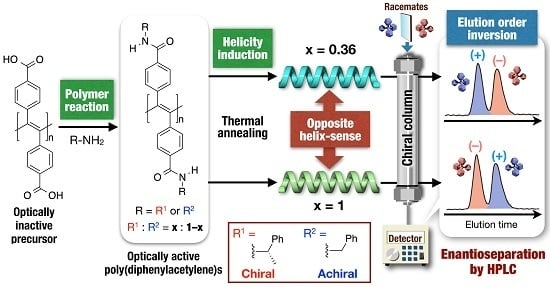Synthesis of Optically Active Poly(diphenylacetylene)s Using Polymer Reactions and an Evaluation of Their Chiral Recognition Abilities as Chiral Stationary Phases for HPLC
Abstract
:1. Introduction
2. Results and Discussion
3. Materials and Methods
3.1. Reagents and Materials
3.2. Instruments
3.3. Synthesis of Monomer
3.4. Polymerization
3.5. Synthesis of Poly-2S by Using a Polymer Reaction
3.6. Synthesis of Poly-(2Sx-co-31−x) by Using Polymer Reactions
3.7. Preparation of High-Performance Liquid Chromatography (HPLC) Columns
4. Conclusions
Supplementary Materials
Acknowledgments
Author Contributions
Conflicts of Interest
References
- Shen, J.; Okamoto, Y. Efficient separation of enantiomers using stereoregular chiral polymers. Chem. Rev. 2016, 116, 1094–1138. [Google Scholar] [CrossRef] [PubMed]
- Ikai, T.; Okamoto, Y. Structure control of polysaccharide derivatives for efficient separation of enantiomers by chromatography. Chem. Rev. 2009, 109, 6077–6101. [Google Scholar] [CrossRef] [PubMed]
- Okamoto, Y.; Ikai, T. Chiral HPLC for efficient resolution of enantiomers. Chem. Soc. Rev. 2008, 37, 2593–2608. [Google Scholar] [CrossRef] [PubMed]
- Francotte, E.; Lindner, W. Chirality in Drug Research; Wiley-VCH: Weinheim, Germany, 2006. [Google Scholar]
- Subramanian, G. Chiral Separation Techniques: A practical Approach, 3rd ed.; Wiley-VCH: Weinheim, Germany, 2007. [Google Scholar]
- Andersson, S.; Allenmark, S.G. Preparative chiral chromatographic resolution of enantiomers in drug discovery. J. Biochem. Biophys. Methods 2002, 54, 11–23. [Google Scholar] [CrossRef]
- Gasparrini, F.; Misiti, D.; Villani, C. High-performance liquid chromatography chiral stationary phases based on low-molecular-mass selectors. J. Chromatogr. A 2001, 906, 35–50. [Google Scholar] [CrossRef]
- Ward, T.J.; Farris Iii, A.B. Chiral separations using the macrocyclic antibiotics: A review. J. Chromatogr. A 2001, 906, 73–89. [Google Scholar] [CrossRef]
- Davankov, V.A. Enantioselective ligand exchange in modern separation techniques. J. Chromatogr. A 2003, 1000, 891–915. [Google Scholar] [CrossRef]
- Lämmerhofer, M.; Lindner, W. Liquid chromatographic enantiomer separation and chiral recognition by cinchona alkaloid-derived enantioselective separation materials. In Advances in Chromatography; CRC Press: Boca Raton, FL, USA, 2007; Volume 46, pp. 1–107. [Google Scholar]
- D’Acquarica, I.; Gasparrini, F.; Misiti, D.; Pierini, M.; Villani, C. HPLC chiral stationary phases containing macrocyclic antibiotics: Practical aspects and recognition mechanism. In Advances in Chromatography; CRC Press: Boca Raton, FL, USA, 2007; Volume 46, pp. 109–173. [Google Scholar]
- Yamamoto, C.; Okamoto, Y. Optically active polymers for chiral separation. Bull. Chem. Soc. Jpn. 2004, 77, 227–257. [Google Scholar] [CrossRef]
- Yashima, E. Polysaccharide-based chiral stationary phases for high-performance liquid chromatographic enantioseparation. J. Chromatogr. A 2001, 906, 105–125. [Google Scholar] [CrossRef]
- Nakano, T. Optically active synthetic polymers as chiral stationary phases in HPLC. J. Chromatogr. A 2001, 906, 205–225. [Google Scholar] [CrossRef]
- Okamoto, Y.; Yashima, E. Polysaccharide derivatives for chromatographic separation of enantiomers. Angew. Chem. Int. Ed. 1998, 37, 1020–1043. [Google Scholar] [CrossRef]
- Yashima, E.; Maeda, K.; Iida, H.; Furusho, Y.; Nagai, K. Helical polymers: Synthesis, structures, and functions. Chem. Rev. 2009, 109, 6102–6211. [Google Scholar] [CrossRef] [PubMed]
- Ishidate, R.; Shimomura, K.; Ikai, T.; Kanoh, S.; Maeda, K. Macromolecular helicity induction and memory in a poly(biphenylylacetylene) bearing an ester group and its application to a chiral stationary phase for high-performance liquid chromatography. Chem. Lett. 2015, 44, 946–948. [Google Scholar] [CrossRef]
- Zhang, C.; Wang, H.; Yang, T.; Ma, R.; Liu, L.; Sakai, R.; Satoh, T.; Kakuchi, T.; Okamoto, Y. Synthesis and chiral recognition of helical poly(phenylacetylene)s bearing l-phenylglycinol and its phenylcarbamates as pendants. J. Polym. Sci. A Polym. Chem. 2015, 53, 809–821. [Google Scholar] [CrossRef]
- Zhang, C.; Ma, R.; Wang, H.; Sakai, R.; Satoh, T.; Kakuchi, T.; Liu, L.; Okamoto, Y. Influence of helical structure on chiral recognition of poly(phenylacetylene)s bearing phenylcarbamate residues of l-phenylglycinol and amide linage as pendants. Chirality 2015, 27, 500–506. [Google Scholar] [CrossRef] [PubMed]
- Anger, E.; Iida, H.; Yamaguchi, T.; Hayashi, K.; Kumano, D.; Crassous, J.; Vanthuyne, N.; Roussel, C.; Yashima, E. Synthesis and chiral recognition ability of helical polyacetylenes bearing helicene pendants. Polym. Chem. 2014, 5, 4909–4914. [Google Scholar] [CrossRef]
- Shimomura, K.; Ikai, T.; Kanoh, S.; Yashima, E.; Maeda, K. Switchable enantioseparation based on macromolecular memory of a helical polyacetylene in the solid state. Nat. Chem. 2014, 6, 429–434. [Google Scholar] [CrossRef] [PubMed]
- Zhang, C.; Wang, H.; Geng, Q.; Yang, T.; Liu, L.; Sakai, R.; Satoh, T.; Kakuchi, T.; Okamoto, Y. Synthesis of helical poly(phenylacetylene)s with amide linkage bearing l-phenylalanine and l-phenylglycine ethyl ester pendants and their applications as chiral stationary phases for HPLC. Macromolecules 2013, 46, 8406–8415. [Google Scholar] [CrossRef]
- Zhang, C.; Liu, F.; Li, Y.; Shen, X.; Xu, X.; Sakai, R.; Satoh, T.; Kakuchi, T.; Okamoto, Y. Influence of stereoregularity and linkage groups on chiral recognition of poly(phenylacetylene) derivatives bearing l-leucine ethyl ester pendants as chiral stationary phases for HPLC. J. Polym. Sci. A Polym. Chem. 2013, 51, 2271–2278. [Google Scholar] [CrossRef]
- Naito, Y.; Tang, Z.; Iida, H.; Miyabe, T.; Yashima, E. Enantioseparation on helical poly(phenylacetylene)s bearing cinchona alkaloid pendants as chiral stationary phases for HPLC. Chem. Lett. 2012, 41, 809–811. [Google Scholar] [CrossRef]
- Yashima, E.; Matsushima, T.; Nimura, T.; Okamoto, Y. Enantioseparation on optically active stereoregular polyphenylacetylene derivatives as chiral stationary phases for HPLC. Korea Polym. J. 1996, 4, 139–146. [Google Scholar]
- Yashima, E.; Huang, S.; Okamoto, Y. An optically active stereoregular polyphenylacetylene derivative as a novel chiral stationary phase for HPLC. J. Chem. Soc. Chem. Commun. 1994, 1811–1812. [Google Scholar] [CrossRef]
- Kim, H.; Seo, K.-U.; Jin, Y.-J.; Lee, C.-L.; Teraguchi, M.; Kaneko, T.; Aoki, T.; Kwak, G. Highly emissive, optically active poly(diphenylacetylene) having a bulky chiral side group. ACS Macro Lett. 2016, 5, 622–625. [Google Scholar] [CrossRef]
- Kim, H.; Lee, D.; Lee, S.; Suzuki, N.; Fujiki, M.; Lee, C.-L.; Kwak, G. Optically active conjugated polymer from solvent chirality transfer polymerization in monoterpenes. Macromol. Rapid Commun. 2013, 34, 1471–1479. [Google Scholar] [CrossRef] [PubMed]
- San Jose, B.A.; Matsushita, S.; Akagi, K. Lyotropic chiral nematic liquid crystalline aliphatic conjugated polymers based on disubstituted polyacetylene derivatives that exhibit high dissymmetry factors in circularly polarized luminescence. J. Am. Chem. Soc. 2012, 134, 19795–19807. [Google Scholar] [CrossRef] [PubMed]
- Zhang, X.A.; Qin, A.; Tong, L.; Zhao, H.; Zhao, Q.; Sun, J.Z.; Tang, B.Z. Synthesis of functional disubstituted polyacetylenes bearing highly polar functionalities via activated ester strategy. ACS Macro Lett. 2012, 1, 75–79. [Google Scholar] [CrossRef]
- Lee, D.; Jin, Y.-J.; Kim, H.; Suzuki, N.; Fujiki, M.; Sakaguchi, T.; Kim, S.K.; Lee, W.-E.; Kwak, G. Solvent-to-polymer chirality transfer in intramolecular stack structure. Macromolecules 2012, 45, 5379–5386. [Google Scholar] [CrossRef]
- Jim, C.K.W.; Lam, J.W.Y.; Leung, C.W.T.; Qin, A.; Mahtab, F.; Tang, B.Z. Helical and luminescent disubstituted polyacetylenes: Synthesis, helicity, and light emission of poly(diphenylacetylene)s bearing chiral menthyl pendant groups. Macromolecules 2011, 44, 2427–2437. [Google Scholar] [CrossRef]
- Fukushima, T.; Tsuchihara, K. Syntheses and chirality control of optically active poly(diphenylacetylene) derivatives. Macromolecules 2009, 42, 5453–5460. [Google Scholar] [CrossRef]
- Teraguchi, M.; Suzuki, J.; Kaneko, T.; Aoki, T.; Masuda, T. Enantioselective permeation through membranes of chiral helical polymers prepared by depinanylsilylation of poly(diphenylacetylene) with a high content of the pinanylsilyl group. Macromolecules 2003, 36, 9694–9697. [Google Scholar] [CrossRef]
- Aoki, T.; Kobayashi, Y.; Kaneko, T.; Oikawa, E.; Yamamura, Y.; Fujita, Y.; Teraguchi, M.; Nomura, R.; Masuda, T. Synthesis and Properties of Polymers from Disubstituted Acetylenes with Chiral Pinanyl Groups. Macromolecules 1998, 32, 79–85. [Google Scholar] [CrossRef]
- Maeda, K.; Maruta, M.; Shimomura, K.; Ikai, T.; Kanoh, S. Chiral recognition ability of an optically active poly(diphenylacetylene) as a chiral stationary phase for HPLC. Chem. Lett. 2016, 45, 1063–1065. [Google Scholar] [CrossRef]
- Shiotsuki, M.; Sanda, F.; Masuda, T. Polymerization of substituted acetylenes and features of the formed polymers. Polym. Chem. 2011, 2, 1044–1058. [Google Scholar] [CrossRef]
- Liu, J.; Lam, J.W.Y.; Tang, B.Z. Acetylenic polymers: Syntheses, structures, and functions. Chem. Rev. 2009, 109, 5799–5867. [Google Scholar] [CrossRef] [PubMed]
- Yuan, W.Z.; Qin, A.; Lam, J.W.Y.; Sun, J.Z.; Dong, Y.; Häussler, M.; Liu, J.; Xu, H.P.; Zheng, Q.; Tang, B.Z. Disubstituted polyacetylenes containing photopolymerizable vinyl groups and polar ester functionality: Polymer synthesis, aggregation-enhanced emission, and fluorescent pattern formation. Macromolecules 2007, 40, 3159–3166. [Google Scholar] [CrossRef]
- Maeda, K.; Okamoto, Y. Synthesis and conformational characteristics of poly(phenyl isocyanate)s bearing an optically active ester group. Macromolecules 1999, 32, 974–980. [Google Scholar] [CrossRef]
- Koe, J.R.; Fujiki, M.; Motonaga, M.; Nakashima, H. Cooperative helical order in optically active poly(diarylsilylenes). Macromolecules 2001, 34, 1082–1089. [Google Scholar] [CrossRef]
- Morino, K.; Maeda, K.; Okamoto, Y.; Yashima, E.; Sato, T. Temperature dependence of helical structures of poly(phenylacetylene) derivatives bearing an optically active substituent. Chem. Eur. J. 2002, 8, 5112–5120. [Google Scholar] [CrossRef]
- Deng, J.P.; Tabei, J.; Shiotsuki, M.; Sanda, F.; Masuda, T. Variation of helical pitches driven by the composition of N-propargylamide copolymers. Macromolecules 2004, 37, 9715–9721. [Google Scholar] [CrossRef]
- Tabei, J.; Shiotsuki, M.; Sato, T.; Sanda, F.; Masuda, T. Control of helix sense by composition of chiral-achiral copolymers of N-propargylbenzamides. Chem. Eur. J. 2005, 11, 3591–3598. [Google Scholar] [CrossRef] [PubMed]
- Takei, F.; Onitsuka, K.; Takahashi, S.; Terao, K.; Sato, T. Control of helical structure in random copolymers of chiral and achiral aryl isocyanides prepared with palladium-platinum mu-ethynediyl complexes. Macromolecules 2007, 40, 5245–5254. [Google Scholar] [CrossRef]
- Nagata, Y.; Nishikawa, T.; Suginome, M. Exerting control over the helical chirality in the main chain of sergeants-and-soldiers-type poly(quinoxaline-2,3-diyl)s by changing from random to block copolymerization protocols. J. Am. Chem. Soc. 2015, 137, 4070–4073. [Google Scholar] [CrossRef] [PubMed]
- Sato, T.; Terao, K.; Teramoto, A.; Fujiki, M. On the composition-driven helical screw-sense inversion of chiral-achiral random copolymers. Macromolecules 2002, 35, 5355–5357. [Google Scholar] [CrossRef]
- San Jose, B.A.; Matsushita, S.; Moroishi, Y.; Akagi, K. Disubstituted liquid crystalline polyacetylene derivatives that exhibit linearly polarized blue and green emissions. Macromolecules 2011, 44, 6288–6302. [Google Scholar] [CrossRef]
- Okamoto, Y.; Aburatani, R.; Hatada, K. Chromatographic chiral resolution: XIV. Cellulose tribenzoate derivatives as chiral stationary phases for high-performance liquid chromatography. J. Chromatogr. A 1987, 389, 95–102. [Google Scholar] [CrossRef]
- Okamoto, Y.; Kawashima, M.; Hatada, K. Chromatographic resolution: XI. Controlled chiral recognition of cellulose triphenylcarbamate derivatives supported on silica gel. J. Chromatogr. A 1986, 363, 173–186. [Google Scholar] [CrossRef]
- Kunishima, M.; Kawachi, C.; Monta, J.; Terao, K.; Iwasaki, F.; Tani, S. 4-(4,6-dimethoxy-1,3,5-triazin-2-yl)-4-methyl-morpholinium chloride: An efficient condensing agent leading to the formation of amides and esters. Tetrahedron 1999, 55, 13159–13170. [Google Scholar] [CrossRef]
- Koller, H.; Rimböck, K.-H.; Mannschreck, A. High-pressure liquid chromatography on triacetylcellulose. J. Chromatogr. A 1983, 282, 89–94. [Google Scholar] [CrossRef]
- Sample Availability: Samples of the compounds are available from the authors.
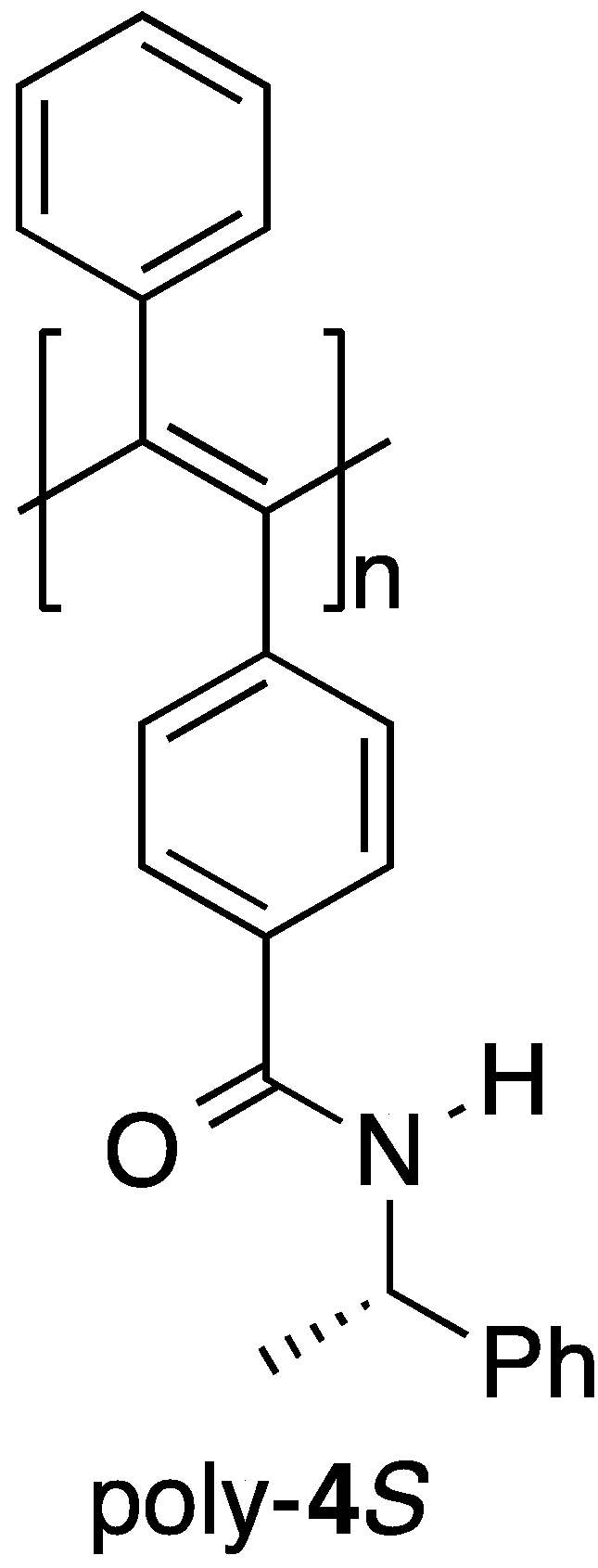
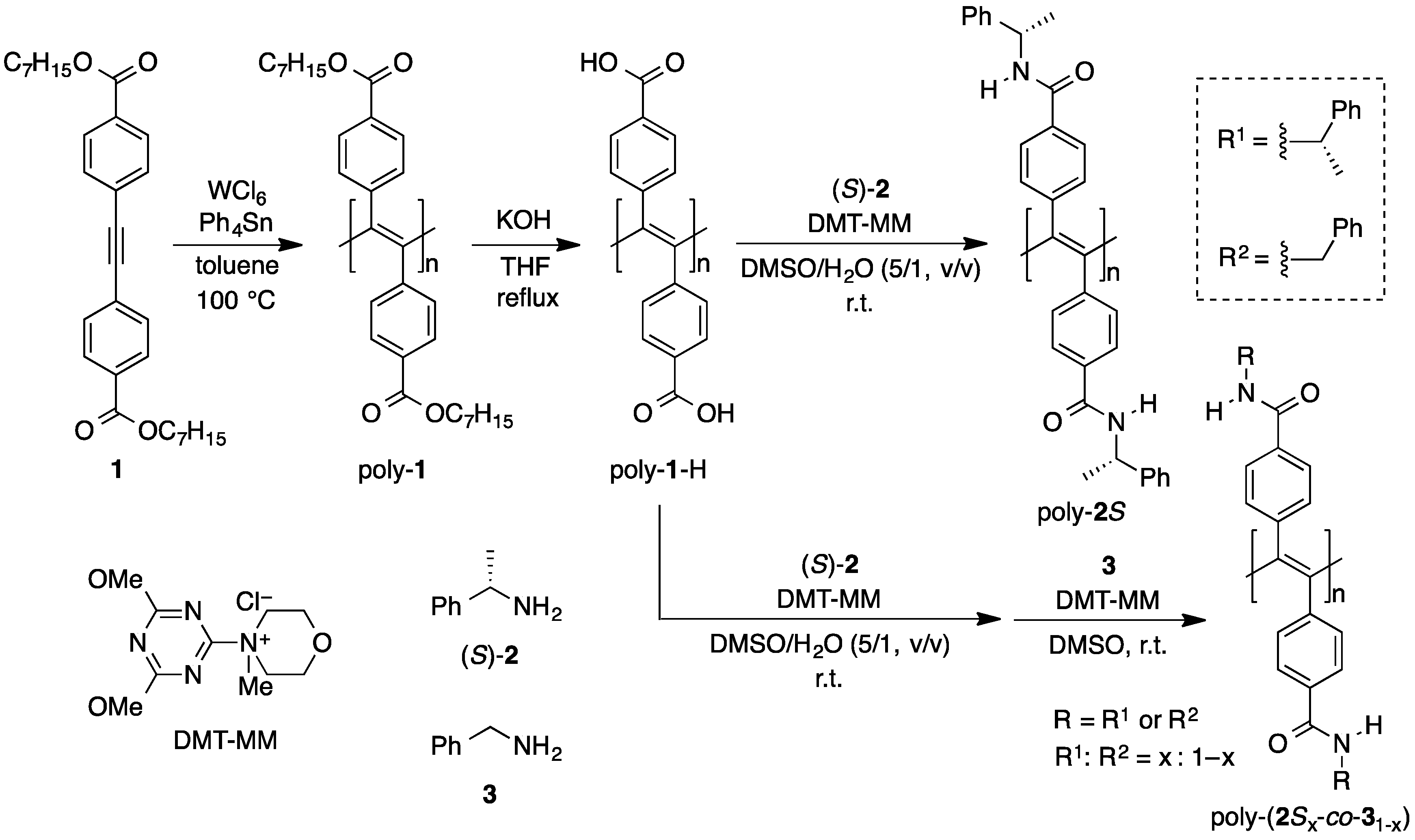

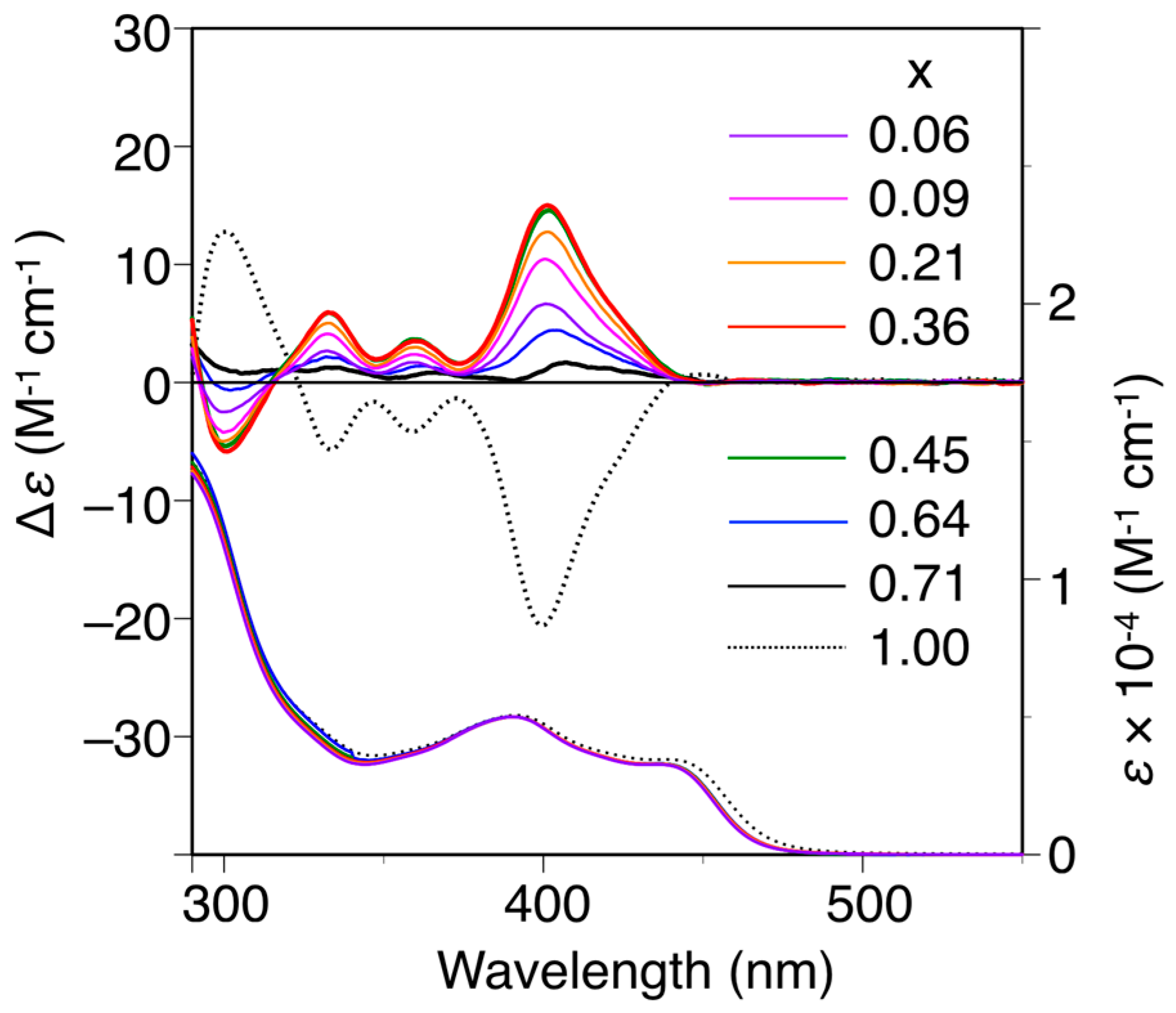
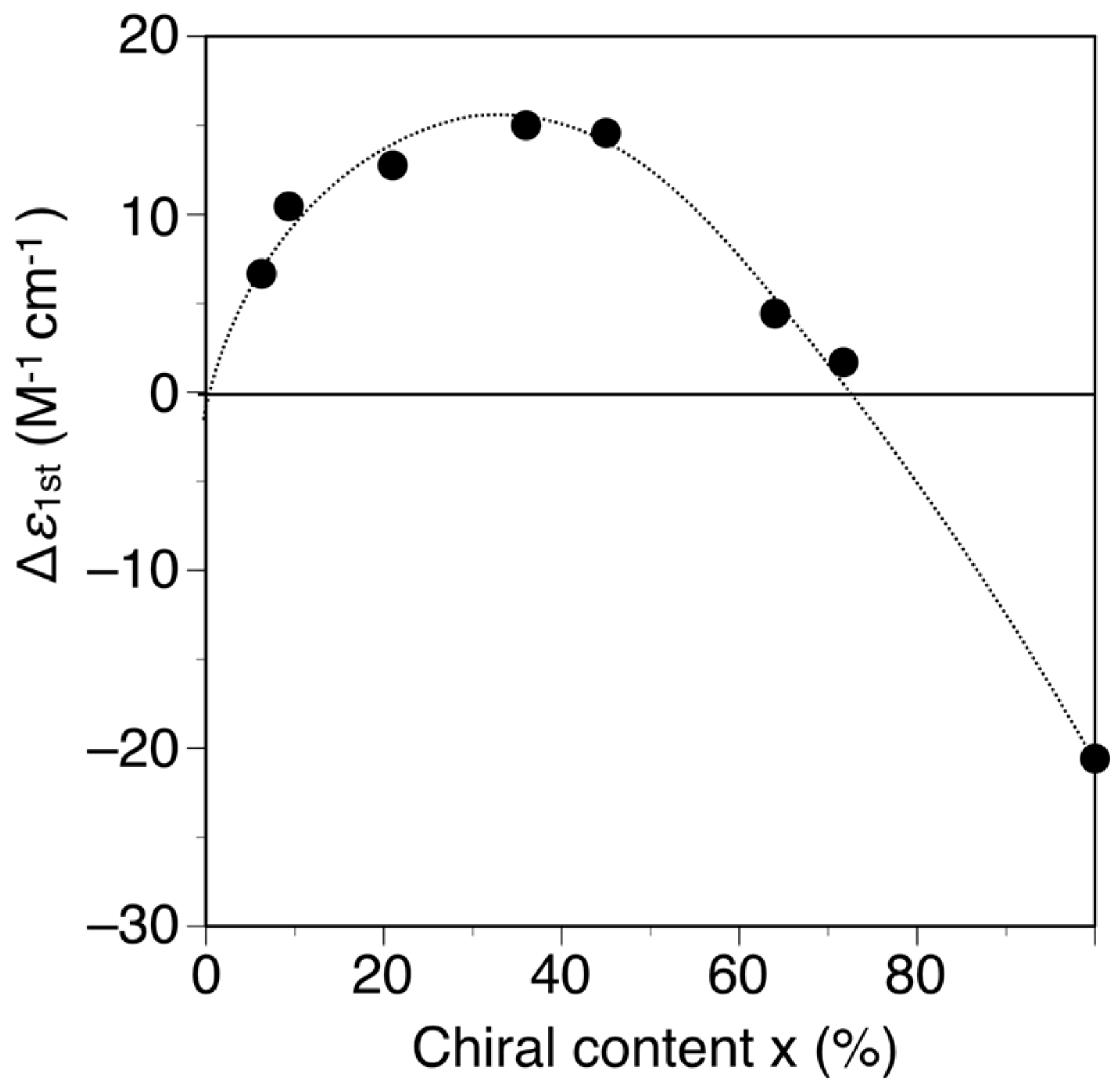
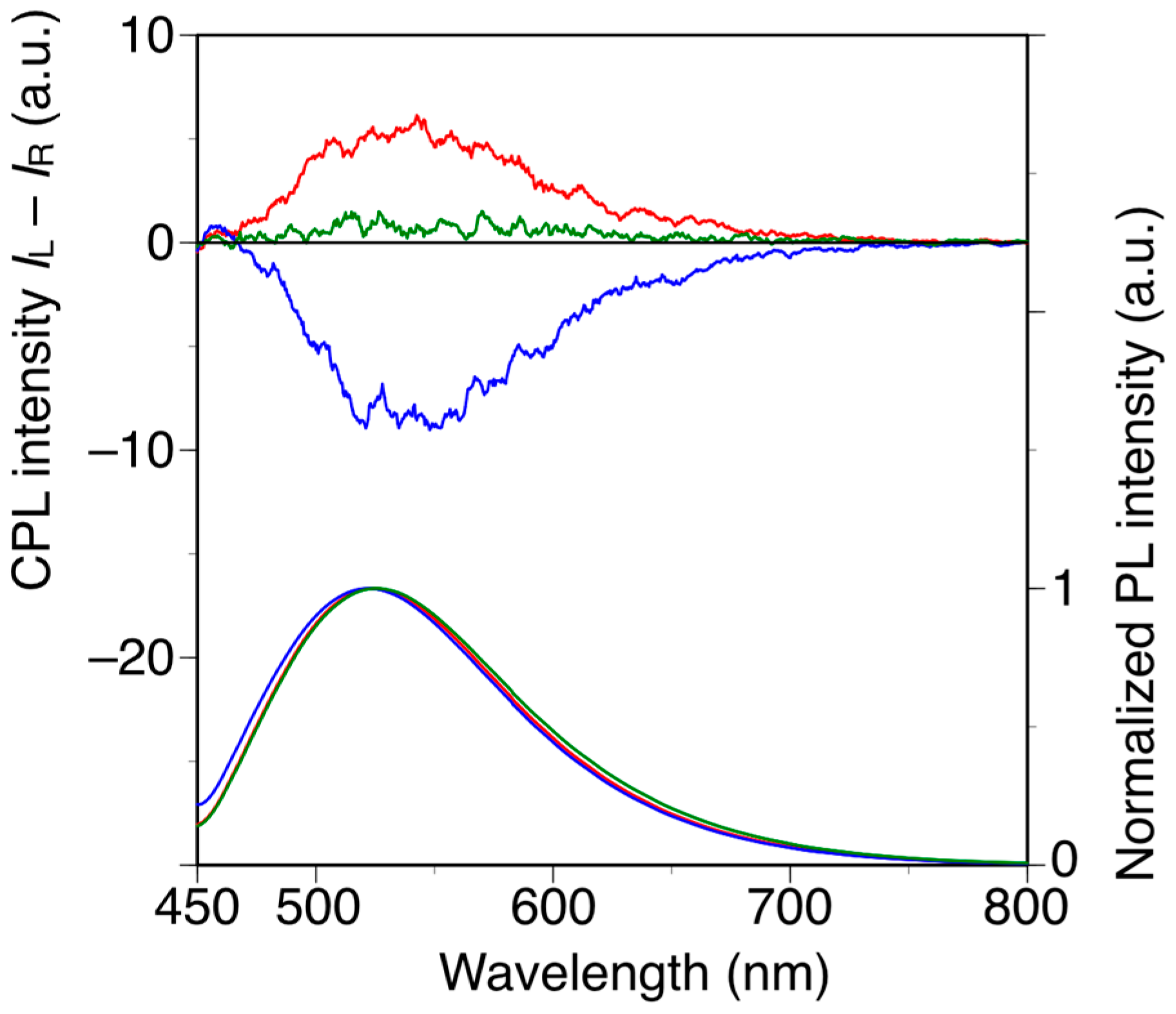

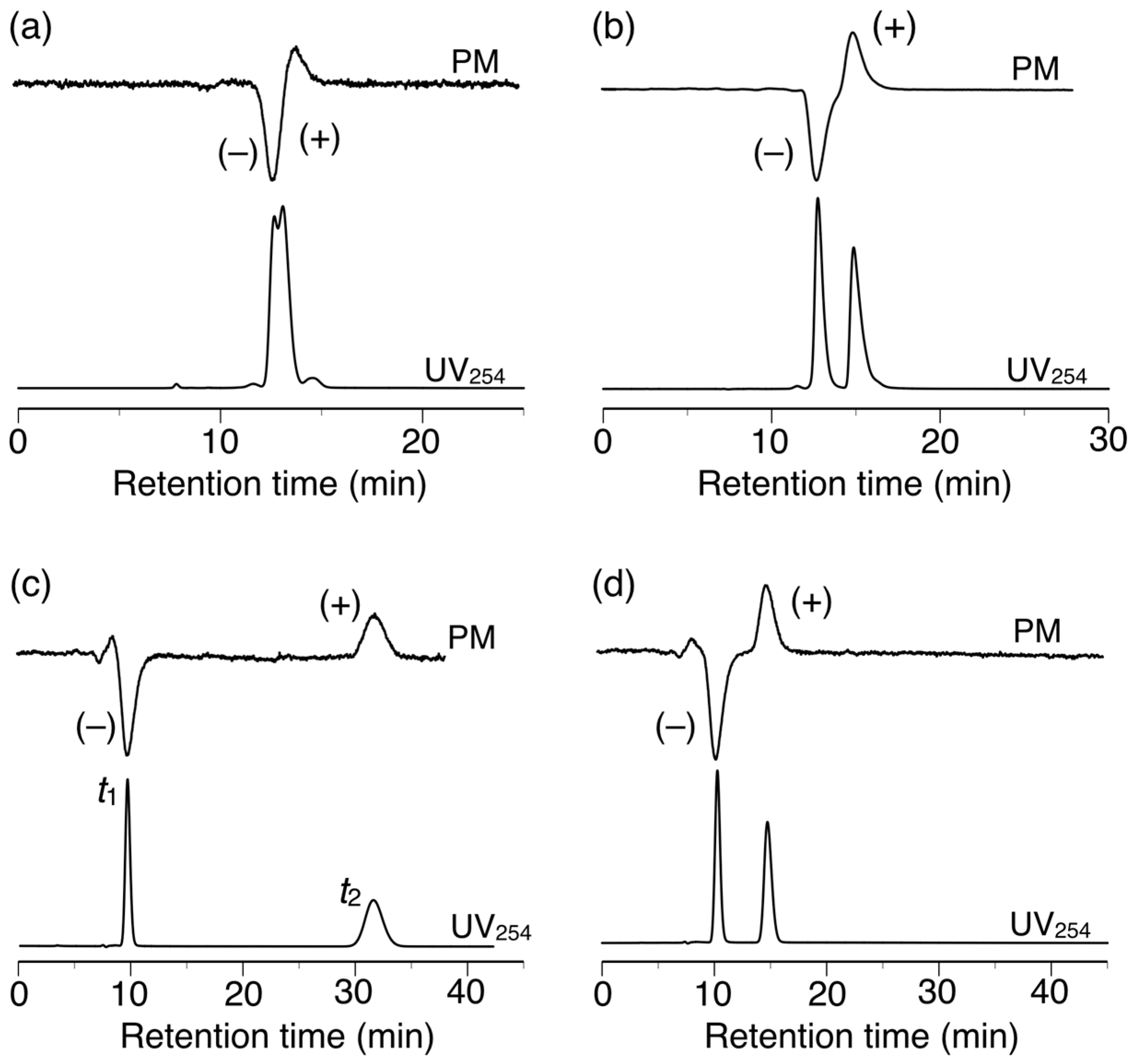
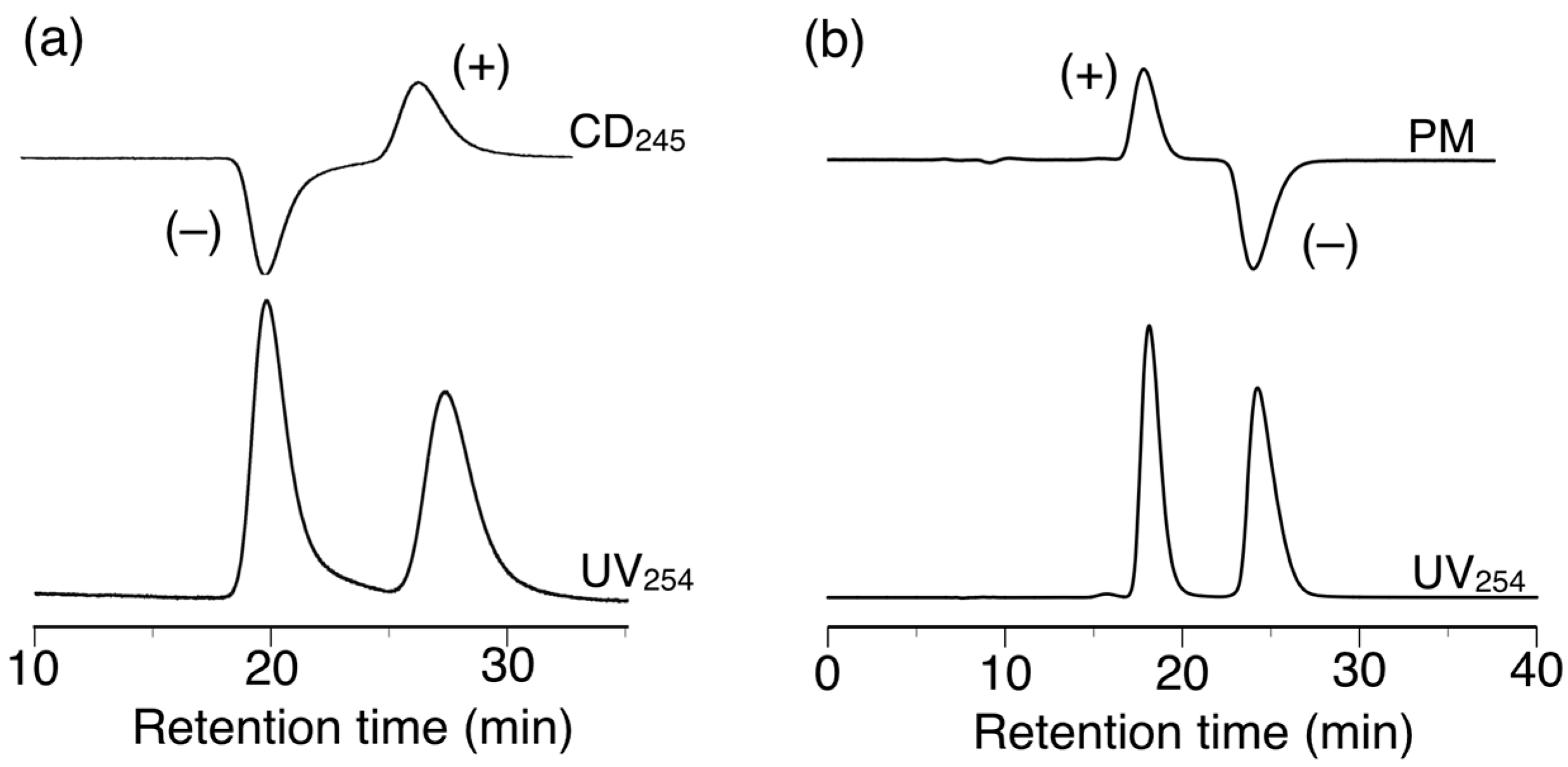
| Racemates | Poly-2S | h-poly-2S | h-Poly-(2S0.36-co-30.64) | h-Poly-4S e | ||||||||
|---|---|---|---|---|---|---|---|---|---|---|---|---|
| k1 | α | Rs | k1 | α | Rs | k1 | α | Rs | k1 | α | Rs | |
| 5 | 0.90 (−) | 1.17 | 1.27 | 1.39 (−) | 1.25 | 1.96 | 2.81 (+) | 1.07 | 0.90 | 1.75 (−) | 1.06 | 0.86 |
| 6 | 0.47 (−) | ca. 1 | — | 0.60 (−) | ca. 1 | — | 1.49 (+) | 1.09 | 0.83 | 1.16 (−) | 1.14 | 1.06 |
| 7 | 0.14 (+) | ca. 1 | — | 0.12 (+) | ca. 1 | — | 0.25 (−) | ca. 1 | — | 0.41 (−) | ca. 1 | — |
| 8 | 0.90 (+) | ca. 1 | — | 0.74 (+) | 1.14 | 1.15 | 7.19 (+) | 1.07 | 0.95 | 5.71 (+) | 1.13 | 1.63 |
| 9 | 0.90 (+) d | ca. 1 | — | 0.93 (+) d | 1.14 | 0.92 | 1.90 (−) d | 1.07 | 0.65 | 2.14 | 1.0 | — |
| 10 | 3.62 (+) | 1.05 | 0.86 | 3.24 (+) | ca. 1 | — | 0.61 (+) | ca. 1 | — | 0.46 (+) | ca. 1 | — |
| 11 | 8.94 (+) | 1.13 | 1.72 | 12.4 (+) | 1.20 | 2.49 | 17.6 (+) | 1.04 | 0.50 | 22.7 (+) | 1.16 | 1.43 |
| 12 b | 0.47 (+) | 1.44 | 1.18 | 0.41 (+) | 1.48 | 1.07 | 3.84 (+) | ca. 1 | — | 1.10 (+) | 1.51 | 1.08 |
| 13 b | 1.57 (−) | 1.30 | 1.83 | 1.91 (−) | 1.38 | 1.74 | 3.56 (+) | 1.16 | 1.13 | 3.91 | 1.0 | — |
| 14 | 1.06 | 1.0 | — | 0.94 | 1.0 | — | 4.36 (−) | 1.50 | 3.16 | 4.02 (−) d | 1.98 | 3.09 |
| 15 | 0.74 (−) | 1.08 | 0.78 | 0.80 (−) | 1.38 | 2.03 | 1.52 (+) | 1.56 | 2.43 | 1.45 (−) | 1.16 | 0.92 |
| 16 c | 0.14 (−) | 19.5 | 10.2 | 0.29 (−) | 2.94 | 3.99 | 7.21 (−) | 2.53 | 6.01 | 0.18 (+) | 2.59 | 2.09 |
| 17 c | 0.39 (+) | 15.3 | 13.5 | 0.61 (+) | 3.00 | 6.31 | 9.92 (+) | 2.84 | 6.69 | 0.28 (−) | 2.60 | 2.88 |
| 18 c | 0.64 (−) d | 17.5 | 15.7 | 0.97 (−) d | 3.64 | 8.88 | 17.3 (−) d | 2.92 | 7.09 | 0.45 (+) d | 2.38 | 3.33 |
© 2016 by the authors. Licensee MDPI, Basel, Switzerland. This article is an open access article distributed under the terms and conditions of the Creative Commons Attribution (CC-BY) license ( http://creativecommons.org/licenses/by/4.0/).
Share and Cite
Maeda, K.; Maruta, M.; Sakai, Y.; Ikai, T.; Kanoh, S. Synthesis of Optically Active Poly(diphenylacetylene)s Using Polymer Reactions and an Evaluation of Their Chiral Recognition Abilities as Chiral Stationary Phases for HPLC. Molecules 2016, 21, 1487. https://doi.org/10.3390/molecules21111487
Maeda K, Maruta M, Sakai Y, Ikai T, Kanoh S. Synthesis of Optically Active Poly(diphenylacetylene)s Using Polymer Reactions and an Evaluation of Their Chiral Recognition Abilities as Chiral Stationary Phases for HPLC. Molecules. 2016; 21(11):1487. https://doi.org/10.3390/molecules21111487
Chicago/Turabian StyleMaeda, Katsuhiro, Miyuki Maruta, Yuki Sakai, Tomoyuki Ikai, and Shigeyoshi Kanoh. 2016. "Synthesis of Optically Active Poly(diphenylacetylene)s Using Polymer Reactions and an Evaluation of Their Chiral Recognition Abilities as Chiral Stationary Phases for HPLC" Molecules 21, no. 11: 1487. https://doi.org/10.3390/molecules21111487
APA StyleMaeda, K., Maruta, M., Sakai, Y., Ikai, T., & Kanoh, S. (2016). Synthesis of Optically Active Poly(diphenylacetylene)s Using Polymer Reactions and an Evaluation of Their Chiral Recognition Abilities as Chiral Stationary Phases for HPLC. Molecules, 21(11), 1487. https://doi.org/10.3390/molecules21111487




